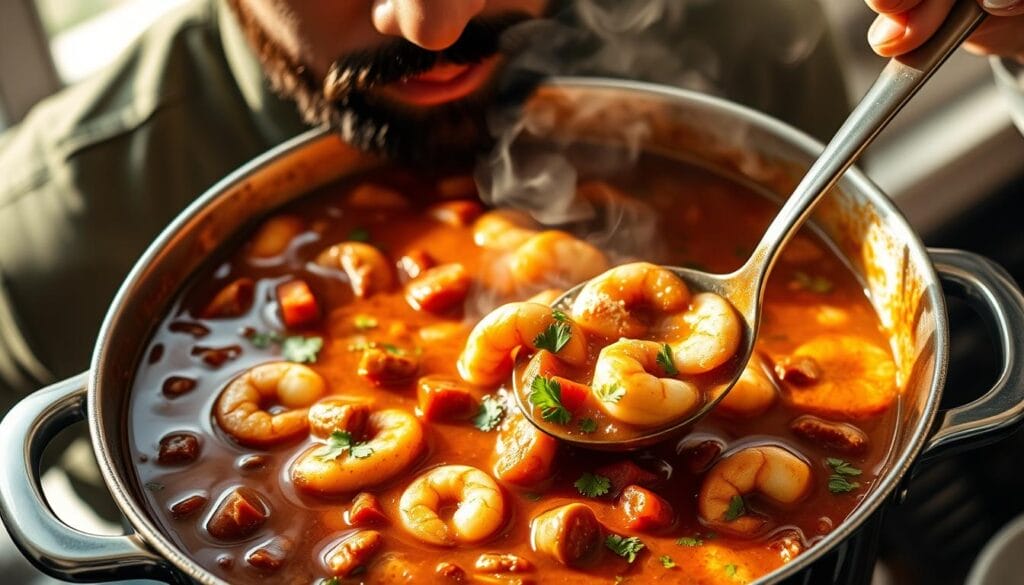I’m excited to share with you the world of gumbo, a spicy seafood stew from Louisiana. It’s a key part of Creole cuisine, rich in history and culture. This Louisiana seafood stew is loved at gatherings and special events, and I’m excited to share its flavors with you.
Gumbo is deeply rooted in Louisiana’s culture and has gained popularity across the United States. Its unique mix of ingredients and spices showcases the state’s culinary heritage. If you love seafood or want to try something new, gumbo is a must-try.
Key Takeaways
- Gumbo is a spicy seafood stew that originated in Louisiana
- It’s a staple of Creole cuisine and is known for its rich history and cultural significance
- Gumbo is a popular dish at social gatherings and special events
- It’s made with a variety of ingredients, including seafood, spices, and vegetables
- Gumbo is a true representation of Louisiana’s culinary heritage
- The recipe yields 10 servings and can be refrigerated for up to 3 days or frozen for up to 8 months
- Gumbo is recognized as the official dish of Louisiana, and its most common types include poultry, seafood, or a combination of both
A Brief History of Gumbo
Gumbo, Louisiana’s official state cuisine, has a long and rich history. It started in Louisiana and was shaped by African, French, and Spanish cuisines. The first written gumbo recipes were in the early 19th century, with a 1824 cookbook being the first to share a recipe.
This spicy gumbo recipe has changed over time. It was influenced by the cultures that settled in Louisiana. The African influence is seen in the use of okra, which comes from West Africa. The French and Spanish added tomatoes and spices, making gumbo what it is today.
The history of gumbo shows Louisiana’s cultural diversity. The Choctaw Native Americans added filé (ground sassafras leaves) as a thickener. Today, gumbo is a cherished dish in Louisiana. Many families have their own spicy gumbo recipe that shows their cultural heritage and connection to Creole cuisine.
The Essential Ingredients for Gumbo
Making a tasty Louisiana seafood stew, or gumbo, starts with key ingredients. The base is onions, bell peppers, and celery, known as the holy trinity. They add flavor and texture to the dish.
Protein and seafood are also important. Shrimp, sausage, and chicken are common choices. You can mix them to get different flavors. For example, Andouille sausage adds spice, while shrimp gives a seafood flavor.
Here are some key ingredients for your gumbo:
- 1 large onion, diced
- 4 ribs of celery, diced
- 1 green bell pepper, diced
- 1 pound of shrimp, peeled and deveined
- 1 pound of Andouille sausage, sliced
These ingredients will help you make a hearty, flavorful gumbo. Whether you stick to traditional recipes or try new ones, the most important thing is to have fun and be creative.
The Magic of the Roux
The roux is key in a spicy gumbo recipe. It’s a mix of flour and fat that makes gumbo thick and flavorful. In Creole cooking, making the roux is an art. You cook it slowly, stirring constantly, until it’s just right.
Making a roux takes time, as it goes from white to dark brown. It’s important to stir it constantly to avoid burning. With patience, you can get the perfect roux, which adds a rich flavor to your gumbo.
There are many types of roux, each for different dishes. White roux is good for creamy sauces, while dark brown is best for stews and gumbo. In Creole cooking, the right roux can change the flavor and texture of your dish. Learning to make a roux can make your gumbo taste truly authentic.
To make the perfect roux, use the right flour and fat, and cook it slowly. With practice, you can make a delicious gumbo that will impress anyone. Whether you’re experienced or new to cooking, mastering the roux is a skill that will enhance your Creole dishes.
Adding Spice: How to Season Gumbo
Gumbo, a traditional Louisiana seafood stew, is famous for its spicy taste. To make it hot, hot sauce and spices are added. Herbs and aromatics bring depth and complexity. The choice and amount of spices depend on what you like, like cayenne pepper, paprika, and thyme.
Some common spices used to season gumbo include:
- Paprika: adds a smoky flavor
- Cayenne pepper: adds heat
- Thyme: adds a savory flavor
Seasoning gumbo right is key to a great taste. A gumbo recipe can be tweaked to fit your taste. Spices and seasonings are what make it special. Whether you like it mild or spicy, finding the right flavor balance is the goal.
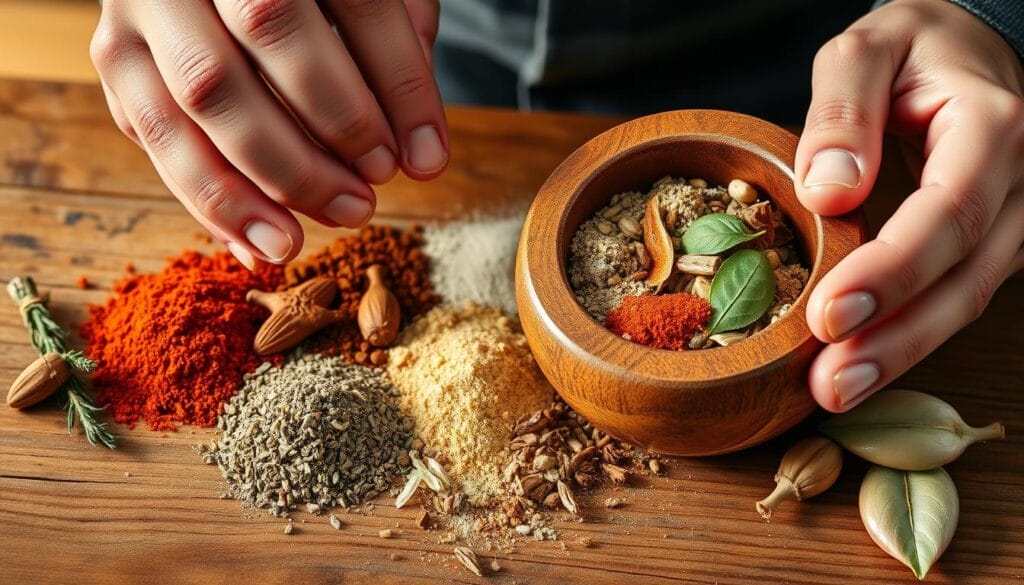
The Cooking Process: Steps to Perfect Gumbo
To make a tasty spicy gumbo, follow a step-by-step guide. Simmer the stew over low heat for at least an hour. This lets the flavors mix well and the ingredients cook slowly. This method is key in Creole cuisine.
Here’s a breakdown of the cooking process:
- Start by heating oil in a large pot over medium-high heat.
- Add chopped onion, celery, and green pepper, and sauté until the vegetables are tender.
- Add the smoked sausage and cook for about 5 minutes, until browned.
- Add the chicken broth, bay leaf, and other spices, and bring the mixture to a boil.
- Reduce the heat to low and simmer, uncovered, for at least an hour, or until the gumbo has thickened and the flavors have melded together.
While simmering, you can add seafood, meat, and veggies to make your gumbo even better. The secret to a great gumbo is slow cooking. This lets the flavors blend and the ingredients tenderize. This traditional method is what makes a gumbo truly special in Creole cuisine.
By following these steps and using the right ingredients, you’ll make a delicious and authentic spicy gumbo. It’s perfect for fans of Creole cuisine or anyone wanting to try something new. This traditional cooking method will soon become a favorite in your kitchen.
| Ingredient | Quantity |
|---|---|
| Chicken broth | 9 cups |
| Smoked sausage | 1¾ cups chopped or thinly sliced |
| Onion | ¾ cup finely chopped |
| Celery | ¾ cup finely chopped |
| Green pepper | ¾ cup finely chopped |
Serving Suggestions for the Best Experience
Serving gumbo, a traditional Louisiana seafood stew, requires a few key tips. It’s best served over a bed of rice. This helps soak up the flavorful broth. The rice balances the bold flavors of the gumbo, making it a staple in Louisiana cuisine.
Adding scallions and parsley can enhance the dish. They add a fresh, oniony flavor and a burst of color. For a more filling meal, serve gumbo with crusty French bread or a green salad. Pair it with a cold beer or sweet tea to cut the richness.
Some popular side dishes for gumbo include:
- Fried okra
- Hush puppies
- Collard greens
- Cornbread
These sides offer different textures and flavors. They help round out the meal. Whether it’s for a casual dinner or a special occasion, these suggestions make the experience memorable and enjoyable.
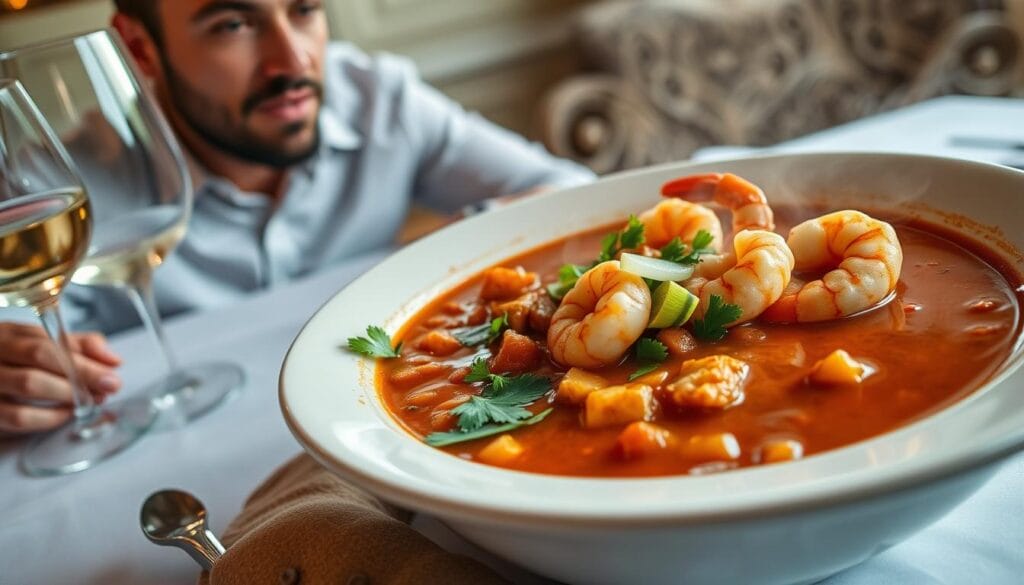
By following these serving suggestions, you can enhance your gumbo’s flavor. This delicious and hearty Louisiana seafood stew is sure to impress. So, get creative and find your favorite way to serve and enjoy it.
| Side Dish | Prep Time | Cook Time |
|---|---|---|
| Fried Okra | 10 minutes | 10 minutes |
| Hush Puppies | 15 minutes | 20 minutes |
| Collard Greens | 20 minutes | 45 minutes |
| Cornbread | 15 minutes | 30 minutes |
Variations of Gumbo: Exploring Options
Gumbo, the official dish of Louisiana, comes in many flavors. You can find seafood, chicken and sausage, and even vegetarian gumbo. Each one has its own special ingredients and taste.
What makes gumbo exciting is trying different proteins and spices. For a spicy gumbo, add more cayenne pepper. For a milder taste, use fewer spices.
Popular gumbo types include chicken and smoked sausage, seafood, and okra or wild game. These dishes are inspired by Creole cuisine’s rich heritage. Creole cuisine uses local ingredients and bold flavors.
When making gumbo, I draw from Louisiana’s traditional recipes. But I also add my own twist to make it unique and tasty.
Gumbo stands out because it’s so versatile. You can make it spicy or mild, depending on your preference. The choice of thickening agents, like filé, okra, or roux, also changes the dish’s texture and taste.
Exploring gumbo’s many variations is rewarding. It lets me try new recipes and ingredients. This way, I can create my own signature spicy gumbo.
In Louisiana, places like Dooky Chase and Brigtsen’s are known for their gumbo. They serve traditional recipes and innovative twists. By trying different gumbo variations, you can discover a wide range of flavors. You might even find your favorite spicy gumbo recipe.
How to Make Gumbo Ahead of Time
As a fan of Louisiana seafood stew, I often wonder how to make gumbo ahead of time. The good news is that gumbo can be made ahead of time. It can be refrigerated or frozen for later use. This makes it easy to reheat and serve, perfect for busy weeknights.
To make gumbo ahead of time, just follow the recipe instructions. Let it cool before refrigerating or freezing. When reheating gumbo, it’s important to do so safely. Use medium-low heat on the stove top, stirring occasionally.
Here are some tips for making gumbo ahead of time:
- Prepare the recipe as instructed, then let it cool before refrigerating or freezing.
- Reheat the gumbo using medium-low heat on the stove top, stirring occasionally.
- Store gumbo in the refrigerator for up to 4 days or freeze for up to 2 months.
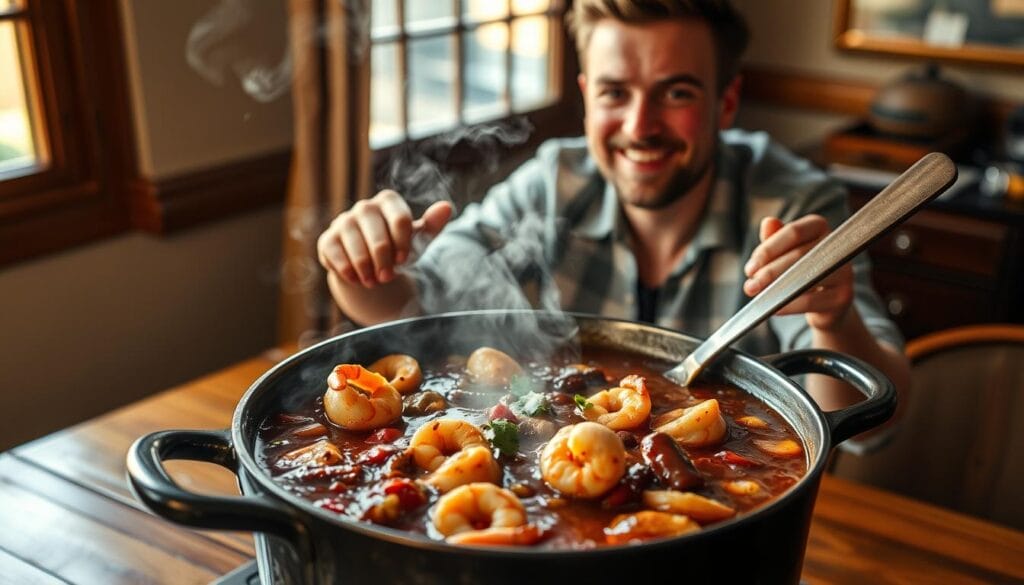
By following these tips, you can enjoy a delicious Louisiana seafood stew, even on busy weeknights. So go ahead, try making gumbo ahead of time. Experience the convenience and flavor of this beloved dish.
For more information on making gumbo, including recipes and cooking tips, visit easykitchen.me for inspiration and guidance. With a little planning and preparation, you can enjoy a delicious bowl of gumbo. It’s made with love and care, just like a traditional Louisiana seafood stew.
Soup or Stew? Understanding Gumbo’s Identity
Gumbo is often debated as to whether it is a soup or a stew. Some say it’s a thick stew, while others see it as a thin soup. This debate is common in many dishes, where the choice between soup and stew depends on ingredients and cooking methods.
In Creole cuisine, gumbo is often seen as a main course. Its thick texture, thanks to a dark roux, makes it more like a stew. Yet, its broth and variety of ingredients, like seafood and veggies, also make it soup-like. Whether it’s a soup or stew is up to personal opinion, and it’s enjoyed both ways.
Here is a comparison of the characteristics of soups and stews:
| Characteristic | Soup | Stew |
|---|---|---|
| Texture | Thin and brothy | Thick and hearty |
| Ingredients | Broth, vegetables, and sometimes meat or seafood | Meat or seafood, vegetables, and sometimes broth |
| Cooking method | Boiling or simmering | Braising or stewing |
Sharing My Gumbo Tradition with Family
Thinking about my favorite gumbo recipes brings back happy memories. Sharing this Louisiana seafood stew with my family is special. Gumbo is more than food; it’s a tradition that unites us.
Preparing gumbo is a labor of love. It takes patience and dedication. The whole process, from start to finish, can take about 3.5 hours. But the delicious Louisiana seafood stew that comes out is worth it.
Some of my top gumbo recipes are:
- Shrimp and sausage gumbo
- Chicken and okra gumbo
- Creole tomato gumbo
These recipes are not only tasty but also show the variety of ingredients used in gumbo. Serving gumbo at family gatherings or special events always makes it a hit.
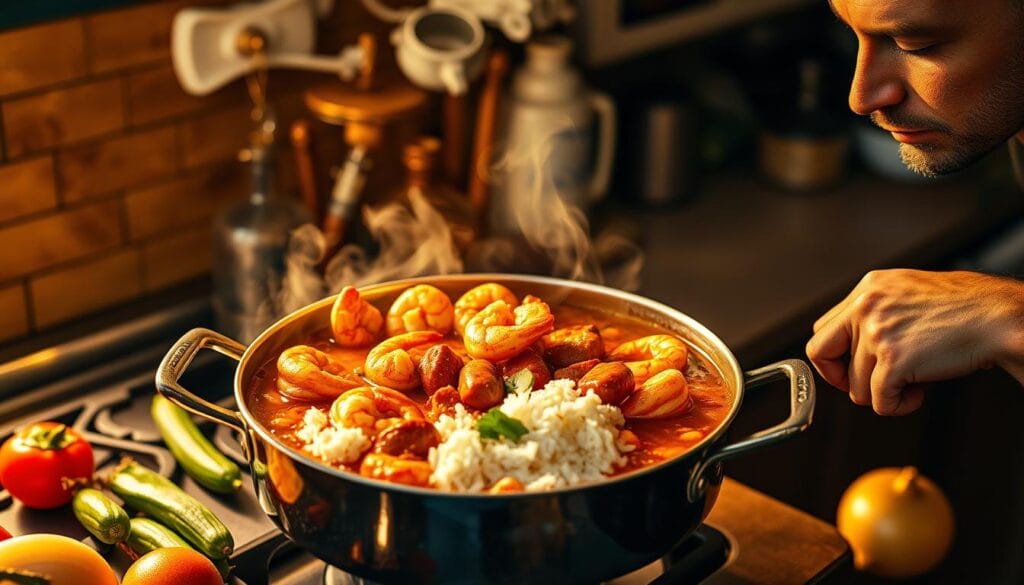
Sharing my gumbo tradition with family and friends reminds me of its rich history and cultural importance. From Louisiana to the rest of the United States, gumbo has become a favorite. I invite you to try different gumbo recipes and make it a part of your tradition.
Frequently Asked Questions about Gumbo
Exploring gumbo has led to many questions. I’ll answer some common ones about this dish. Gumbo is a key part of Creole cuisine, loved by many for its spicy flavors.
Gumbo is known for its flexibility with ingredients and spices. The main difference between Cajun and Creole gumbo is in the seasonings. Creole gumbo uses more seasonings and fresh herbs. Knowing these differences is key to making a tasty spicy gumbo.
Some common questions about gumbo include:
- What is the difference between Cajun and Creole gumbo?
- How do I make a spicy gumbo recipe?
- What are the essential ingredients for gumbo?
Understanding gumbo’s basics is important. It’s the Official State Cuisine of Louisiana. Its spicy gumbo recipe shows the state’s rich culinary history. Exploring gumbo’s types, like Creole cuisine, deepens our appreciation for it.
In conclusion, gumbo is a complex dish with many flavors and ingredients. By answering common questions, we learn more about this beloved Creole cuisine staple.
Final Thoughts: Why I Love Gumbo
Thinking about gumbo’s history and cultural importance, I feel a deep love for this Louisiana seafood stew. It comes from West Africa, where “gumbo” means “okra.” This dish has been a key part of Louisiana’s food scene for over a century. It brings people together at gatherings and special events.
I love how gumbo captures the spirit of Creole cuisine. The “trinity” of vegetables – celery, onion, and green pepper – add a unique flavor. The roux, made by stirring for up to 30 minutes, is what holds the dish together.
Enjoying a bowl of chicken and smoked sausage gumbo is always rewarding. Gumbo’s flexibility lets me try new things, from meats and seafood to spices and herbs. It’s a journey that satisfies my taste buds and connects me to Louisiana’s rich culture.
FAQ
What is gumbo?
Gumbo is a spicy seafood stew from Louisiana. It’s a key part of Creole cuisine. It has a rich history and is deeply rooted in culture.
What are the essential ingredients in gumbo?
Gumbo’s base includes onions, bell peppers, and celery, known as the “holy trinity.” It also has proteins like shrimp, sausage, and chicken.
What is the importance of the roux in gumbo?
The roux, made from flour and fat, is vital. It thickens the stew and adds flavor.
What spices and seasonings are used in gumbo?
Spices like hot sauce, cayenne pepper, paprika, and thyme are used. They add heat and flavor.
How is gumbo typically served?
Gumbo is served over white rice. It’s garnished with scallions and parsley for freshness and texture.
What are the different variations of gumbo?
Gumbo comes in many forms, like seafood, chicken and sausage, and vegetarian. Each has its own flavors and ingredients.
Can gumbo be made ahead of time?
Yes, gumbo can be made ahead. It can be refrigerated or frozen for later, perfect for busy nights.
Is gumbo a soup or a stew?
The debate rages on whether gumbo is a soup or stew. Some see it as a thick stew, while others call it a thin soup.

